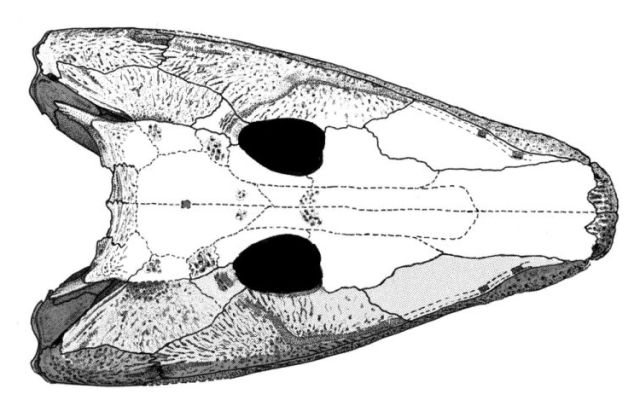Our Curator of Natural Sciences, Dr Gerard McGowan has written this latest blog for us – about our rather popular Pholiderpeton. He writes
One of the most important specimens in Bradford Museums’ Collections is Pholiderpeton scutigerum (NS.111.81), a fossil tetrapod from the Carboniferous Period that is approximately 315 million years old (see Figs 1 & 2).


This wonderful specimen was collected in 1868 from a local coal colliery, Toftshaw Bottom, by a local miner Mr William Firth of Dudley Hill, Bradford. The fossil was made known to Louis Compton Miall (1842-1921), curator of the Bradford Philosophical Society (BPS) (see Fig. 3). L.C. Miall’s notes for his autobiography suggest that he visited the colliery and went down a mine for the first time in his life to see the fossil in situ. There it was wrapped in plaster for extraction. William Firth also gave some talks about its finding.

L. C. Miall then forwarded the fossil to his friend and colleague, the esteemed comparative anatomist and palaeontologist, Prof. Thomas Henry Huxley (1825-1895). It was T.H. Huxley a friend and supporter of Charles Darwin, who declared it a genus and species new to science and named it as the holotype , formally describing it in 1869. T.H. Huxley, a leading scientist of his day, was a popularizer of science, supporter of education for all, and proponent of Archaeopteryx as a sister group to dinosaurs.

So why is Pholiderpeton so important? Well this fossil, when first found in 1864 was a phenomenal discovery of a well preserved, almost complete animal for the then burgeoning field of palaeontology and evolution. It was discovered only 9 years after the publication of Charles Darwin’s famous ‘On the Origin of Species’ in 1859. At that time there was still much controversy about evolution even though there were thousands of fossils supporting it. Today, of course, biological evolution is supported by millions of fossils, genetics research, palaeontology, molecular biology, anthropology and is accepted by every scientific institution of note across the world.

Scientific work on the Pholiderpeton fossil in the 1980s by PhD candidate Jenny Alice Clack (1947- ) (currently Emeritus Professor and Curator of Vertebrate Palaeontology, University Museum of Zoology, University of Cambridge) under the supervision of Dr Alec Leonard Panchen (1930-2013) at Newcastle University showed that the fossil had the first middle ear bones known to science from this group of amphibians, the first complete front legs and shoulder girdle and, until the 1980s, was the oldest tetrapod in Europe. Although overtaken by an older Scottish fossil tetrapod, it could still be called the oldest in England.

Pholiderpeton has a middle ear bone, called the stapes. that has a foramen (small hole) for the passing of a nerve through it. This is one of the characters associated with mammals. This indicates that Pholiderpeton was closely related to the ancestors of mammals. This relationship is also supported by the shape of the vertebrae.
As the holotype specimen all subsequent fossils of this type must be compared with it to verify their identification. This makes the specimen very important indeed as there can only be one holotype for each species.
At the time Pholiderpeton was alive around 315 million years ago, in the Geological Period called the Carboniferous, Yorkshire was situated close to the equator and the area was a large swampy forest, somewhat like the Florida everglades today. It was warmer than it is today and oxygen levels were higher
Two of the most important evolutionary developments during this period were the evolution of bark fibre lignin and the cleidoic egg. Possibly the greatest biological innovation of this period was the development of the cleidoic egg which helped prevent desiccation of the embryo within the egg. This allowed some tetrapods to exploit further reaches of the terrestrial ecosystem that restrained others that were tied to water to lay their eggs (fish, amphibians).
Lignin allowed the appearance of bark bearing trees, this in combination with the low sea levels and tropical climates led to the formation of the great coal measures that would later fuel the industrial revolution. It has been argued that, in addition to the high ratios of bark to wood of between 8 to 1 and 20 to 1, compared with modern trees whose ratio is 1 to 4, the vast coal measures developed due to the lack of organisms, at that time, that could feed on lignin,. The extensive burial of vast amounts of biologically produced carbon would have led to a high oxygen content of air as the carbon was buried and locked up under ground. The oxygen content was around 35% compared with today’s 21% which would have led to the arthropod and amphibian gigantism seen in this period. Both these animal groups are size-constrained by oxygen diffusion.
From analyses of the fossil remains it appears that Pholiderpeton climbed into a hollow tree trunk when alive were it was unfortunately buried and became fossilized only to be discovered 315 million years later by local miner William Firth.

This iconic fossil was chosen by the Yorkshire Post in their promotion of a History of Yorkshire in 70 objects
The holotype of Pholiderpeton scutigerum is on display in the Airedale Gallery at Cliffe Castle Museum Keighley.